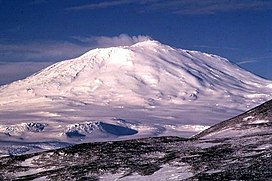| Mount Erebus | |
|---|---|
 Mount Erebus | |
| Highest point | |
| Elevation | 3,792 m (12,441 ft)[1] |
| Prominence | 3,794 m (12,448 ft)[1] Ranked 34th |
| Listing | Ultra |
| Coordinates | 77°31′47″S 167°09′12″E / 77.52972°S 167.15333°E[2] |
| Geography | |
| Location | Ross Island, Antarctica (claimed by New Zealand as part of the Ross Dependency) |
| Topo map | Ross Island |
| Geology | |
| Rock age | 1.3 million years |
| Mountain type | Stratovolcano (composite cone) |
| Volcanic belt | McMurdo Volcanic Group |
| Last eruption | 2020 |
| Climbing | |
| First ascent | March 10, 1908 by Edgeworth David and party. Nimrod Expedition[3][4] |
Mount Erebus (/ˈɛrɪbəs/) is the southernmost active volcano on Earth, located on Ross Island in the Ross Dependency in Antarctica. With a summit elevation of 3,792 metres (12,441 ft), it is the second most prominent mountain in Antarctica (after Mount Vinson) and the second-highest volcano in Antarctica (after the dormant Mount Sidley). It is the highest point on Ross Island, which is also home to three inactive volcanoes: Mount Terror, Mount Bird, and Mount Terra Nova.[citation needed] It makes Ross Island the sixth-highest island on Earth.[5]
The mountain was named by Captain James Clark Ross in 1841 for his ship, HMS Erebus.[2] The volcano has been active for around 1.3 million years and has a long-lived lava lake in its inner summit crater that has been present since at least the early 1970s. On 28 November, 1979, Air New Zealand Flight 901 crashed on Mount Erebus, killing all 257 people on board.
- ^ a b Mount Erebus GVP.
- ^ a b Alberts 1995, p. 223.
- ^ "Antarctic explorers". Australian Antarctic Division. Archived from the original on 22 May 2010. Retrieved 29 December 2008.
- ^ Shackleton, Ernest, ed. (1908). Aurora Australis. Cape Royds, Antarctica: Joyce & Wild.
- ^ "Antarctica Ultra-Prominences", peaklist.org, Aaron Maizlish
